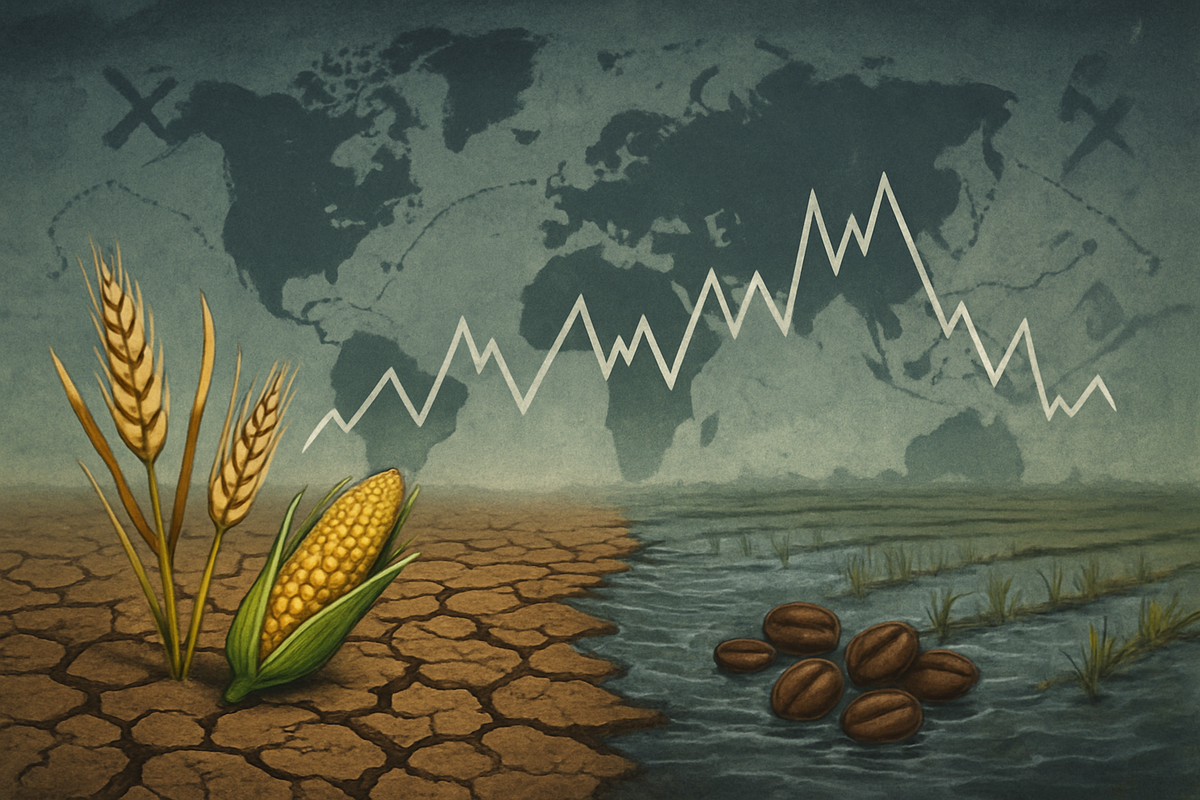Indigenous Communities Are the Frontlines of Climate Action—It’s Time COP Listened – Global Issues.org

Report on the Role of Indigenous Peoples in Climate Action and Achieving Sustainable Development Goals
Executive Summary: Aligning Indigenous Stewardship with Global Goals
Indigenous peoples are essential partners in achieving the Sustainable Development Goals (SDGs), particularly those related to environmental protection and climate action. Despite stewarding over 80 percent of the world’s remaining biodiversity, Indigenous communities are frequently excluded from decision-making processes that affect their lands and livelihoods. This report outlines the critical link between Indigenous rights, land stewardship, and the successful implementation of the global development agenda, advocating for their direct inclusion in climate policy and finance mechanisms.
The Critical Link Between Indigenous Land Rights and SDGs 13, 15, and 16
The recognition of Indigenous land rights is fundamental to making progress on several key SDGs. Secure land tenure for Indigenous communities is a proven strategy for environmental conservation and climate mitigation.
- SDG 13 (Climate Action): Evidence from regions like the Amazon and Africa demonstrates that Indigenous-managed lands exhibit lower rates of deforestation and higher rates of carbon storage compared to other protected areas. Securing these lands is a direct and effective climate action.
- SDG 15 (Life on Land): The vast biodiversity preserved within Indigenous territories underscores their role as the most effective guardians of terrestrial ecosystems. Protecting their land rights is synonymous with protecting global biodiversity.
- SDG 16 (Peace, Justice and Strong Institutions): For Indigenous communities, land rights are a matter of justice and cultural survival. Upholding these rights strengthens institutions and promotes peaceful, inclusive societies by addressing historical inequities.
Case Study: Advancing SDG 16 in the Benimasi-Boadi Community, Ghana
The work of Land Rights Defenders Inc. in the Benimasi-Boadi Indigenous Community Conserved Area provides a tangible example of advancing the SDGs. The organization took decisive action to counter unauthorized exploitation and institutional land grabs, which threatened ancestral lands.
Key interventions aligned with SDG 16 include:
- Submitting spatial data and a formal case study to the United Nations Environment Programme (UNEP) to enforce the principle of Free, Prior, and Informed Consent (FPIC).
- Appealing a biased legal ruling and filing a Special Procedure complaint to the UN Human Rights Council to seek redress for human rights violations.
- Advocating for the enforcement of national legal frameworks, such as Ghana’s Land Act 2020 (Act 1036), to ensure strong and just institutions.
This intervention not only secured a legal victory but also affirmed the community’s right to protect its cultural heritage, directly contributing to the preservation of biodiversity (SDG 15).
Reforming Climate Finance to Support SDG 13 and SDG 17
Current climate finance architecture fails to adequately support on-the-ground action by Indigenous peoples. Less than 1 percent of climate funding reaches Indigenous-led initiatives directly. This misallocation is both unjust and inefficient, hindering progress on SDG 13 (Climate Action). To achieve SDG 17 (Partnerships for the Goals), climate finance must be restructured to:
- Empower Indigenous communities as direct recipients and decision-makers.
- Provide flexible funding that respects Indigenous governance systems.
- Eliminate intermediaries that absorb critical resources.
From Consultation to Consent: Upholding SDG 10 and SDG 16
The practice of “consulting” Indigenous communities after key decisions have been made undermines the principle of Free, Prior, and Informed Consent (FPIC), a cornerstone of the UN Declaration on the Rights of Indigenous Peoples. This approach perpetuates systemic inequalities, working against SDG 10 (Reduced Inequalities) and SDG 16 (Peace, Justice and Strong Institutions). A paradigm shift is required from symbolic inclusion to genuine consent, granting Indigenous communities the power to approve or reject projects that impact their territories.
Integrating Indigenous Knowledge for Enhanced Climate Resilience (SDG 13)
Indigenous knowledge systems represent a repository of time-tested strategies for climate adaptation and resilience. Practices such as controlled burns and traditional water harvesting are sophisticated scientific approaches that can inform and enhance global efforts to meet SDG 13 targets. Protecting this knowledge from misappropriation and building equitable partnerships between Indigenous science and Western science is essential for creating a sustainable future.
Recommendations for Policy Makers to Accelerate SDG Achievement
To ensure climate justice and accelerate progress on the SDGs, the following actions are recommended for governments and international bodies:
- Guarantee Indigenous Land Rights: Implement legal recognition and protection for Indigenous lands to advance SDG 15 and SDG 16.
- Ensure Direct Access to Climate Finance: Restructure financial mechanisms to channel funds directly to Indigenous-led initiatives, supporting SDG 13 and SDG 17.
- Embed FPIC into All Climate Agreements: Mandate the principle of Free, Prior, and Informed Consent in all climate-related policies and projects to uphold SDG 10 and SDG 16.
- Elevate Indigenous Leadership: Ensure Indigenous peoples have formal, decision-making roles in national and international climate negotiations, not just observer status in side events.
- Protect Indigenous Knowledge Systems: Establish ethical and equitable partnerships that recognize and protect Indigenous knowledge as a vital component of climate solutions, contributing to SDG 13.
Analysis of Sustainable Development Goals in the Article
1. Which SDGs are addressed or connected to the issues highlighted in the article?
-
SDG 10: Reduced Inequalities
- The article extensively discusses the exclusion of Indigenous peoples from decision-making processes that affect their lands and futures. It highlights the systemic inequality they face, such as being denied a voice in climate dialogues (“too often excluded from the decisions that shape our lands and futures”) and receiving a disproportionately small share of climate finance. The call to move from “consultation to consent” and ensure their inclusion in decision-making directly addresses the need to reduce inequalities.
-
SDG 13: Climate Action
- The central theme of the article is the critical role of Indigenous communities in climate action. It frames land rights as “climate rights,” arguing that securing Indigenous land tenure is an effective strategy for climate mitigation through reduced deforestation and enhanced carbon storage. The article calls for direct access to climate finance for Indigenous-led initiatives and the integration of Indigenous knowledge into climate adaptation and resilience strategies.
-
SDG 15: Life on Land
- The article directly connects Indigenous stewardship to the preservation of biodiversity and ecosystems. It states that Indigenous territories “hold over 80 percent of the world’s remaining biodiversity” and that “where Indigenous communities have secure land tenure, deforestation rates drop, biodiversity thrives.” The successful intervention in the Benimasi-Boadi Indigenous Community Conserved Area in Ghana is a prime example of efforts to halt biodiversity loss and protect terrestrial ecosystems from unauthorized exploitation.
-
SDG 16: Peace, Justice and Strong Institutions
- This goal is addressed through the article’s focus on legal rights, access to justice, and inclusive institutions. The work of Land Rights Defenders Inc. involves legal advocacy, such as submitting a case study to the UNEP, appealing biased court rulings, and filing complaints with the UN Human Rights Council to seek “redress for victims of human rights violations.” The demand for the enforcement of Free, Prior, and Informed Consent (FPIC) and the championing of Ghana’s Land Act 2020 are calls for stronger, more just, and inclusive institutions that protect fundamental freedoms.
-
SDG 1: No Poverty
- While not the primary focus, SDG 1 is relevant through the lens of land rights. The article states that for Indigenous communities, land rights are the “very foundation of our cultures, livelihoods, and futures.” Securing land tenure provides economic security and control over resources, which is a fundamental step in eradicating poverty and ensuring sustainable livelihoods.
2. What specific targets under those SDGs can be identified based on the article’s content?
-
Under SDG 10 (Reduced Inequalities):
- Target 10.2: “By 2030, empower and promote the social, economic and political inclusion of all, irrespective of age, sex, disability, race, ethnicity, origin, religion or economic or other status.” The article’s core argument is for the political inclusion of Indigenous peoples in climate negotiations and decision-making processes, urging negotiators to “Elevate Indigenous leadership in decision-making spaces, not just side events.”
- Target 10.3: “Ensure equal opportunity and reduce inequalities of outcome, including by eliminating discriminatory laws, policies and practices and promoting appropriate legislation, policies and action in this regard.” The advocacy for the enforcement of Ghana’s Land Act 2020 and the fight against “biased ruling[s]” directly align with this target.
-
Under SDG 13 (Climate Action):
- Target 13.b: “Promote mechanisms for raising capacity for effective climate change-related planning and management in least developed countries and small island developing States, including focusing on women, youth and local and marginalized communities.” The demand for direct climate finance to Indigenous communities (“less than 1 percent reaches Indigenous-led initiatives”) is a call to empower marginalized communities to manage climate action effectively.
-
Under SDG 15 (Life on Land):
- Target 15.2: “By 2020, promote the implementation of sustainable management of all types of forests, halt deforestation, restore degraded forests and substantially increase afforestation and reforestation globally.” The article provides evidence that securing Indigenous land tenure is a direct mechanism to achieve this, stating that in these areas, “deforestation rates drop” and they “outperform even state-protected areas in preserving forest cover.”
- Target 15.5: “Take urgent and significant action to reduce the degradation of natural habitats, halt the loss of biodiversity and, by 2020, protect and prevent the extinction of threatened species.” The article highlights that Indigenous lands hold “over 80 percent of the world’s remaining biodiversity,” and protecting these lands from threats like “extractive industries, infrastructure projects, and even misguided conservation efforts” is crucial to halting biodiversity loss.
-
Under SDG 16 (Peace, Justice and Strong Institutions):
- Target 16.3: “Promote the rule of law at the national and international levels and ensure equal access to justice for all.” The legal actions taken by Land Rights Defenders Inc., such as appealing court rulings and filing complaints to the UN Human Rights Council, are direct efforts to ensure access to justice for the Benimasi-Boadi community.
- Target 16.7: “Ensure responsive, inclusive, participatory and representative decision-making at all levels.” The article’s strong emphasis on the principle of Free, Prior, and Informed Consent (FPIC) and its critique of symbolic “consultation” directly address the need for genuinely inclusive and participatory decision-making.
-
Under SDG 1 (No Poverty):
- Target 1.4: “By 2030, ensure that all men and women, in particular the poor and the vulnerable, have equal rights to economic resources, as well as access to basic services, ownership and control over land and other forms of property…” The call to “Guarantee Indigenous land rights through legal recognition and protection” is a direct effort to secure control over land, which is the foundation of Indigenous livelihoods and economic well-being.
3. Are there any indicators mentioned or implied in the article that can be used to measure progress towards the identified targets?
- Proportion of climate finance directed to Indigenous communities: The article explicitly states that “less than 1 percent [of climate finance] reaches Indigenous-led initiatives.” This figure serves as a direct, quantifiable indicator of the inequity in climate finance distribution and can be used to track progress towards Target 13.b.
- Rates of deforestation and biodiversity loss in Indigenous-managed lands: The article implies this as an indicator by stating that where Indigenous communities have secure tenure, “deforestation rates drop” and “biodiversity thrives.” Comparing these rates with those in state-protected or privately-managed areas can measure the effectiveness of Indigenous stewardship (relevant to Targets 15.2 and 15.5).
- Legal recognition and security of land tenure for Indigenous peoples: Progress can be measured by the number of countries that have legally recognized Indigenous land rights and the proportion of Indigenous lands with secure tenure. The article’s focus on the “enforcement of Ghana’s Land Act 2020 (Act 1036)” points to the importance of not just legislation but its implementation as an indicator (relevant to Target 1.4).
- Implementation of Free, Prior, and Informed Consent (FPIC): The article calls to “Embed FPIC into all climate-related agreements and mechanisms.” The number of projects and policies affecting Indigenous lands that adhere to the full FPIC process (moving beyond mere consultation to consent) can serve as an indicator of inclusive decision-making (relevant to Target 16.7).
- Proportion of global biodiversity conserved within Indigenous territories: The article cites that Indigenous territories “hold over 80 percent of the world’s remaining biodiversity.” Maintaining or increasing this proportion can be an indicator of the success of Indigenous-led conservation efforts (relevant to SDG 15).
4. Create a table with three columns titled ‘SDGs, Targets and Indicators” to present the findings from analyzing the article.
| SDGs | Targets | Indicators |
|---|---|---|
| SDG 1: No Poverty | 1.4: Ensure equal rights to ownership and control over land and other forms of property. | Legal recognition and enforcement of Indigenous land tenure (e.g., enforcement of Ghana’s Land Act 2020). |
| SDG 10: Reduced Inequalities |
10.2: Empower and promote the social, economic and political inclusion of all.
10.3: Ensure equal opportunity and reduce inequalities of outcome. |
Level of Indigenous leadership and participation in decision-making spaces (e.g., at COP); Elimination of biased rulings and discriminatory practices against Indigenous communities. |
| SDG 13: Climate Action | 13.b: Promote mechanisms for raising capacity for effective climate change-related planning and management… including focusing on… local and marginalized communities. | Proportion of climate finance that directly reaches Indigenous-led initiatives (currently cited as “less than 1 percent”). |
| SDG 15: Life on Land |
15.2: Halt deforestation and promote sustainable management of all types of forests.
15.5: Halt the loss of biodiversity and reduce the degradation of natural habitats. |
Rates of deforestation in Indigenous-managed lands compared to other areas; Proportion of global biodiversity conserved within Indigenous territories (currently cited as “over 80 percent”). |
| SDG 16: Peace, Justice and Strong Institutions |
16.3: Promote the rule of law and ensure equal access to justice for all.
16.7: Ensure responsive, inclusive, participatory and representative decision-making at all levels. |
Number of legal and policy mechanisms that embed Free, Prior, and Informed Consent (FPIC); Number of human rights violation cases against Indigenous communities that achieve redress through justice systems. |
Source: globalissues.org
What is Your Reaction?
 Like
0
Like
0
 Dislike
0
Dislike
0
 Love
0
Love
0
 Funny
0
Funny
0
 Angry
0
Angry
0
 Sad
0
Sad
0
 Wow
0
Wow
0
















































:focal(1500,1000)/https://media.globalcitizen.org/a6/9a/a69a4720-d8a1-4715-b596-18738d03c05c/rotary_polio_hero_image.jpg?#)







/countries/sri-lanka/photo-credit---dmc-sri-lanka.tmb-1200v.jpg?sfvrsn=dc298bcc_1#)



















